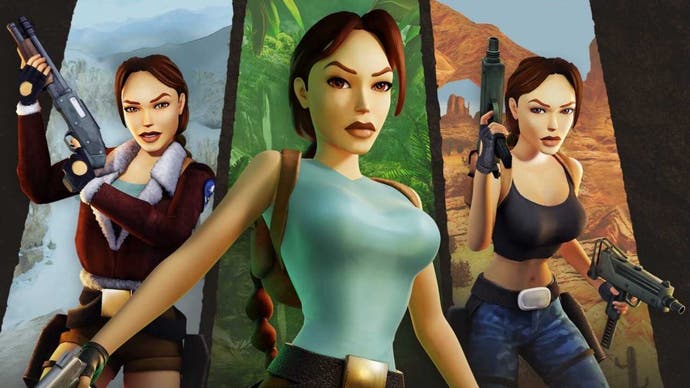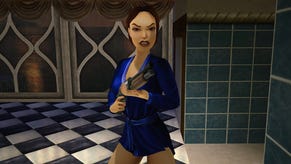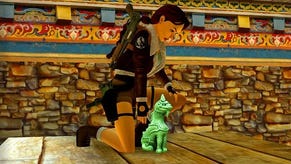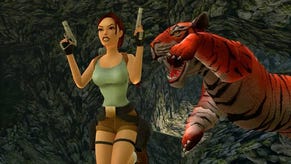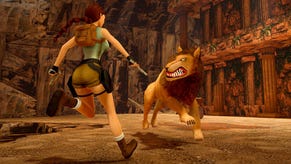Tomb Raider 1-3 Remastered review - you were never going to smooth these games out
Leap of faith.
Games can be beautiful because they are timeless, but they can also be beautiful because they are timely. When it comes to timelessness, you're going to struggle to beat Tetris. Its stark and nested blocks face every age with the same eternal silence, while the impulse to organise and tidy that they inspire is so deeply rooted in living things that it probably transcends species. Just this morning I watched a crow on TikTok working a stick into a clear plastic tube to dislodge a treat. This crow, that lives in a tree somewhere and probably eats the eggs of other birds because it is compelled to, this crow was ready for Tetris.
For timeliness, though, I give you Tomb Raider - the early Core games. These are the same games that have just been repackaged and remastered in a new collection with an annoyingly unwieldy name. And that all fits, to be honest. To play these games is to play - if you're me - something gorgeous and awkward, something that is gorgeous in part because it is awkward. But the timeliness of it all! I cannot even see these games without slipping back to the 1990s. Scream is on at the cinema. My ex-girlfriend is back from a gap year in Australia and keeps saying everything good is "immense". Everyone I know seems to have bought the same record bag to university. Chocolate bars are going through a great Cambrian explosion (forget Snickers, pick me up a Maverick!), and in every halls of residence there is at least one grubby grey plastic PlayStation, sat upside down so the laser works, with people clustered around Lara Croft's latest. They're stuck on a puzzle. They're playing together, as a kind of chorus. They're calling out suggestions. They've all missed the key that is hidden on the floor behind them.
A warning for what follows, then. Tomb Raider isn't just a game to some of us. It's a madeleine, my Maverick bar, dunked in Lucozade, which takes me back to the time that I was rediscovering games in general. And this time is now so distant, these games such a fond but unplayed fixture of my imagination, that just playing this collection is an act of rediscovery itself, by turns thrilling and melancholy, joyous and frustrating.
The good is very good. Someone cared about this collection. It contains the first three Core games, which to me are the classic texts of this era of Tomb Raider. Tomb Raider 1 sets it all up, starting with those wolves and that ice and then delivering an adventure with levels that seem to grow in complexity and ambition as the developers understand the potential they're working with. Then Tomb Raider 2 is my favourite Tomb Raider game, because it's already restless.
Tomb Raider 2! What I love about this game is that, sure, the treasured object you're chasing after is very old - I should say here that the remasters rightly carry a content warning about the racial and ethnic stereotypes they include, and this game's 1990s treatment of Chinese mythology is about as engaged as you'd fear - yet so much of the game sees you Indiana Jonesing through places which are not actually ancient, but are still harmonious with that kind of numinous scale a certain adventure fiction finds in old temples and mysterious dormant machinery. You get an oil rig, a Venetian opera house, a sunken trawler! Rust and industrialisation, and it works! Tomb Raider 3, meanwhile, builds on everything the first games have and dials it up - much too far in crucial respects. As IGN noted today, the game's treatment of South Pacific islanders includes tribesmen "implied to be cannibals" who use blowguns and issue "animal-like cries as they are defeated." Crystal Dynamics ultimately decided to leave these stereotypes in "in the hopes that we may acknowledge its harmful impact and learn from it."
The games have been remodelled with new textures and models and objects, but the same basic geometry. The modern stuff is harmonious, even if it's sometimes a bit too moodily lit for my mid-forties eyesight. It looks like Tomb Raider, and Lara herself looks more like the Tomb Raider from the first Crystal D games - upgraded, sure, but still the same fantastical character. Best of all, you can flick between the modern graphics and the classic graphics with a single button press and no time delay at all. It's a game in itself. You can walk through these levels switching between one graphical style and another every few seconds, warping between the past and the present.
Lovely stuff, and there's a camera mode for if you want to commemorate each moment, and then all three games come with their extra mini-campaigns and with their Croft Manors, that glorious essential component that took Lara from being a video game character and set her on the path to being something like a Sherlock Holmes figure. Not a detective, but a more-rounded creation, with a sense of history, an actual home that we could explore, while she still retained a certain mystery. Her own Baker Street. And it had a walk-in fridge!
Much of this is wonderful and - to be honest here - I love this collection and the effort that has gone into it. But there are mechanical challenges when it comes to the remastering. And before I get to them, I need to explain why they don't actually ruin everything for me, even as I'm aware that they might ruin everything for a lot of people.
In a way, I think early 3D games like Tomb Raider come from a place in game design that feels even more ancient than really early games. This is because of what designers were grappling with, what they were trying to do. Pong, say, retains a certain immediacy even as it reduces Tennis to two radar blips and a few straight lines. You can play it on an oscilloscope, if you happen to have one, and yet there's no cognitive hump to traverse if you do so, and this is because it's delivering a 2D version of a game that instantly makes sense. Mario has that same instant comfort because we all know about left-to-right, and one squeeze of the run button tells us almost everything we want to know about the physics in play too.
But the first Tomb Raider? When that game first came out I did not even understand what I was looking at. I didn't understand how the 2D textures had been arranged to make 3D spaces, I didn't like what I saw at the time as a weird glitch when the textures created little black tesselation artefacts at the edges of the screen. Could I imagine Mario allowing that level of visual imperfection? (Reader: I now love those artefacts.) And when someone eventually handed me a pad, I couldn't work out how to move Lara around. Her design spoke to such grace, but I was clumsy as I stumbled about those first few tombs. I grabbed at ledges and didn't connect. I walked into walls. I fell many times to my death.


What I mean to say here is that I expect a certain amount of awkwardness in a collection that takes games from this era and brings them into the present day. Maybe - is this an argument too far? - I would feel slightly cheated if the awkwardness wasn't there.
Anyway. It has taken me a long time, playing through sections of all three games over the last few weeks, to reach this kind of clarity on things. My first hour with the collection was absolutely horrific. I leaped straight into Tomb Raider 2, that first level, down in the pit beneath the Great Wall of China. A level I had played many times long ago, a level in which I could still remember exactly where to go. And I couldn't do it. I could barely move.
The collection comes with two control schemes, and I started out with the most venerable: tank controls. These were the controls I think I first used back in the day - or a scheme that was very similar to them. You have to steer Lara as if she's a library trolley with a bad wheel. I can almost feel that sensation of pushing forward, but also down, with both hands on the grips in order to move forward. Lara turns, and then her forward might no longer be camera-forward. The relationship between Lara and the camera is complicated, until you learn to understand it, at which point it's still never quite invisible, never quite something you can forget. Instead, and I remember feeling this at the time, Lara versus the camera becomes a meaningful part of each puzzle. It's odd and awkward, but it's consistent, the relationship always works the same way, and so it earns a place in the game as a sort of ghostly mechanical element.
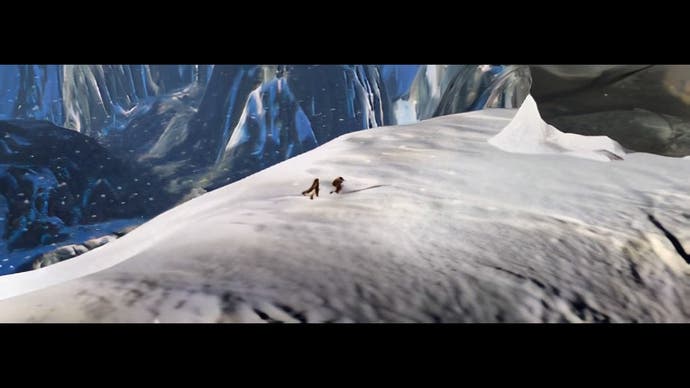

But I have played a lot of games since Tomb Raider 2 and I have been spoiled. Maybe spoiled is the wrong word. One thing I had noticed without really appreciating it over the years is how much modern games use special case context-based fudges and little moments of kindness to ease you through their gauntlets. They will realise that you're aiming for a certain ledge, and like a tall person in Tescos reaching for a high box of Cornflakes for you, they will step in and help and get you there. Tomb Raider 2? Tomb Raider 2 does not do this stuff for you. It does not care what you're trying to do. And so it's almost rudely exacting. Not straight on to a wall? You're probably not going to grab it when you jump. And grabbing a wall takes two buttons, remember, jump and action. Running jump? Fine: how far? Have you moved back enough? Are you sure?
Reader, in the real world, I am learning to swim at the moment, and I am lost in this period of breaking all these movements that should be graceful and smooth and completely mindless down into little pieces that I have to carry in my head and think about, very artificially, in sequence while I'm underwater. And that's what it was like working through the first level of Tomb Raider 2 using tank controls in 2024. I loved it, eventually, and I even got a bit of speed going. And, deep down, I still think this is the right way to play this game. But it's not easy. This was 3D gaming from an era when developers were not working with a lot of best practices in place. This is a game from an era when you were meant to reserve space in your mind at all times to think about the controls - when the controls, the sheer embodiment of being Lara Croft, was sort of the whole deal really.
After a while I switched to modern controls. And here is when I almost had a sort of prolonged Tomb Raider crisis. Modern controls try to bring Core Lara Croft up to the present day. You have the camera on one stick - sort of - and Lara on another, and you can do that thing you do in modern games where you turn the camera and the character sort of follows along. You can recenter the camera behind the character! You can grab ledges automatically. Shooting is suddenly mapped to triggers. A lot of it works.


But a lot of it doesn't. Partly this is because a 3D camera likes to have a meltdown in tight confines regardless of the era. Partly this is because the game is incredibly bad at explaining itself. Srsly. Rooting through menus I struggled to find out how to do that really long jump Lara does, for example. I had to stumble upon photo mode by accident (click the thumbsticks, I think). It took me an age to realise that jumping and grabbing sometimes required a trigger if I was going a long way. And while the camera is modernised, lock-on while shooting is definitely not.
I am an idiot, obviously, so I am happy to take some blame for this. But one night last week I got a Slack message from Ian Higton, who is not an idiot, pleading with me to tell him how to get Lara out of the speedboat from the Venice section. This game does not explain itself enough.
But there is something else, something which I don't think any modernised controls could really square. Classic Tomb Raider is set on a grid. This is why it's so beautiful for some of us to contemplate. The world of Lara Croft is a world of established units. Want to run up for a long jump? Jump back to the start of the grid square you're currently in first. Want to know if you can reach a ledge? Count how many squares up it is. Everything in the games - jungles, Venetian canals, magical worlds composed of floating islands - obeys this grid. And the tank controls are built around them. It offers the same hermetically sealed universe you'd get in the old days when you peered deep into the workings of a typewriter and discovered that every letter got to occupy the same space on the piece of paper.
These modernised controls have a complex relationship with the grid. Over time, I've come to suspect they're haunted by the grid. They know it's there, but they can't seem to acknowledge it, to meet its gaze in a mirror. For example: using modern controls you cannot neatly hop backwards anymore to line up with the side of the current square you're in. This is crucial for measuring out jumps, and you just can't do it. It's harder to do the sideways flip jump, too. Less important for survival, but it always looked cool, and it's part of the Lara-iness of Lara to me. Last week, I was working through a section of Tomb Raider 2 in which I had to jump from one chandelier to another. Each chandelier was one grid square in size, but the modern controls lost me within that small space. Eventually, I had to stop trying to line up and just run and jump blindly. Often it worked. But it was imprecision in a game that historically was a lot of things, but never imprecise.
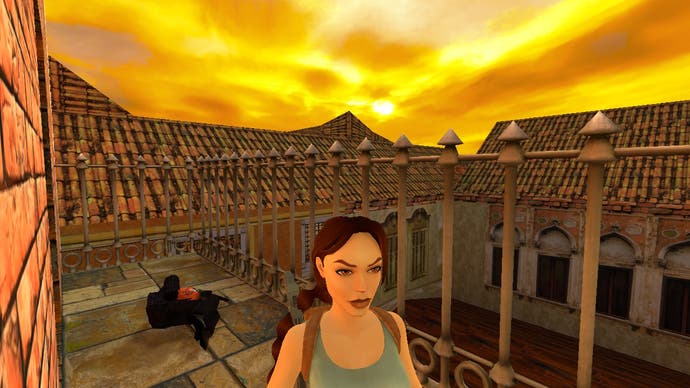
I have come to terms with this, over the last week. I now play the game switching back and forth between controls when the game suits it. I'll do a bit of precision platforming in Tank, and then I'll go Modern for some open tombs with a lot of running and fast reaction stuff. In a gun fight in a small space? Tank. Chased by a boulder? Modern.
This sounds awful, right? But here's the thing. It sounded awful to me at first too. Somewhere along the line, I had fallen into thinking that Tomb Raider was the start of the same lineage as something like Uncharted, which features tombs and raiding and X-never-marks-the-spot and all that jazz, sure, but is actually nothing like the Core Tomb Raiders whatsoever. Below the dressing, it's not even close. Uncharted is like ITV on a Friday night, winging you at speed between this sitcom, this drama, these ads for shampoo and these ads for other Friday nights. It's flow. It does not want you to be stuck. It does not want you to stop. It's a game that wants to dazzle and guide you by the elbow, even as it wants to get out of your way.
This is not Tomb Raider - not Core Tomb Raider anyway. These games wanted platforming to be a challenge and also a puzzle. This was the action here. You stopped and thought and measured and imagined the jump and then did it. It took time. It took a lot of looking around, standing still, saving and coming back to it once your head had cleared and your pulse had settled. Platforming was difficult, because the game wanted you to understand you were controlling this character but you weren't actually her, and she was richly capable in the world and this in turn just made her harder to control.
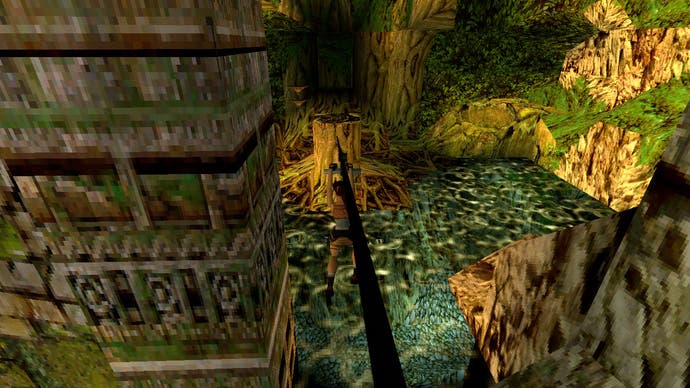
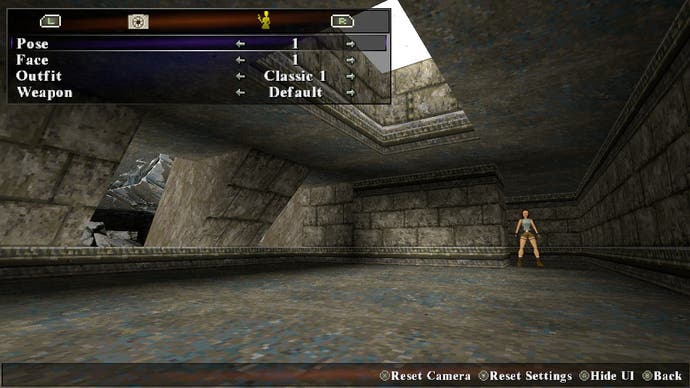

And I know all this because I can remember playing that same sequence that stumped me - the chandelier bit - back in 2000 or 1999 or whatever. I can remember sitting in my bedsit with my old Pentium, working through the chandeliers on a Sunday afternoon, and it took just as long, and included as many false starts, and as much quick-saving. This was the game. And cludgy as the new collection is, that feeling has been preserved.
Oh great, so some annoying games are still annoying? That's missing the richness. Not just the richness of slowly starting to understand the controls, the richness of learning to play them, in essence, like one would learn to play a musical instrument. It also misses the richness that emerged from the hesitations, the getting stuck. I remember Tomb Raider levels so clearly because I spent so very long inside them. Because I was stuck I got their atmosphere, their peculiar delights.
I got their deep, intractable weirdness, too. Not just the way enemies will run in circles shooting blindly or the way every window shattering feels like a sound effect played jarringly over the speakers in regional theatre, absolutely removed from what's happening on the stage. No, the way that things are organised. The way that Venice, say, is a completely empty sprawl of buildings, none of which make any sense. One will house a single switch that unlocks a trap door in the building across the street for example, and this isn't just bizarre, it's gloriously bizarre. Lara's whole world is this puzzle that does not bow to any kind of logic except that of someone playing a platforming and puzzling game. I love this about it.
And I still love this collection, because it's carefully made and lovingly updated, but also awkward, elbowy, frustrating and prone to leaving me stuck. It's a collection that understands that Tomb Raider was absolutely a game about its controls, and it still should be - even if it doesn't quite know how to deliver on that.
Tomb Raider! These old Core games were a lot of things, but they were also the first games I ever went online for, in order to get a solution to a bit that was stopping me from progressing. Guess what. Last night, I went online again and did exactly the same thing, almost three decades later.
A copy of Tomber Raider 1-3 Remastered was provided for review by Crystal Dynamics/Aspyr.
